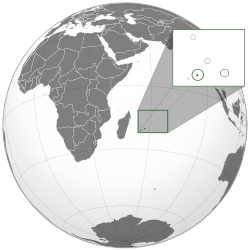

| Light Blue | Cape Verde Time (UTC−1) |
| Blue | Greenwich Mean Time (UTC) |
| Red | (UTC+1) |
| Yellow | (UTC+2) |
| Ochre | (UTC+3) |
| Green | East Africa Time (UTC+3) |
| Turquoise | (UTC+4) |
Locally known as Egypt Standard Time.
Mauritius and the Seychelles are to the east and north-east of Madagascar respectively.
Mauritius Time, or MUT, is the time zone used by the Indian Ocean island nation of Mauritius. The zone is four hours ahead of UTC (UTC+04:00).
Mauritius does not use daylight saving time; however, it has been used in the past. Daylight saving time was first introduced in Mauritius in 1982; however, it was discontinued the following year.[ citation needed ] It was re-introduced in 2008; however, it was not used in 2009 or since. [1] In 2008, the period started at 2 am UTC+5 (1 am UTC+4) on 26 October 2008 (the last Sunday in October), and ended at 2 am UTC+5 (1 am UTC+4) on 29 March 2009 (the last Sunday in March). Mauritius is in the Southern Hemisphere, so summer begins towards the end of the year.